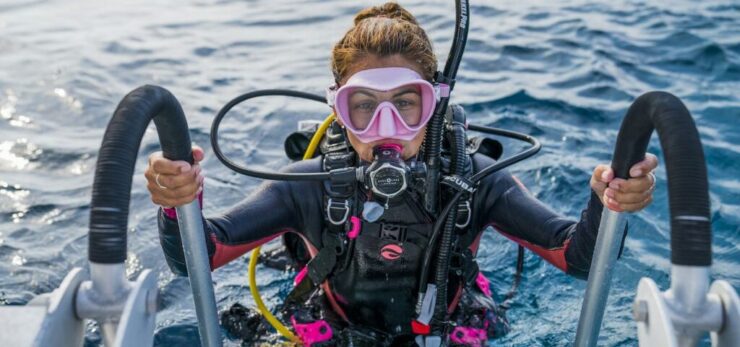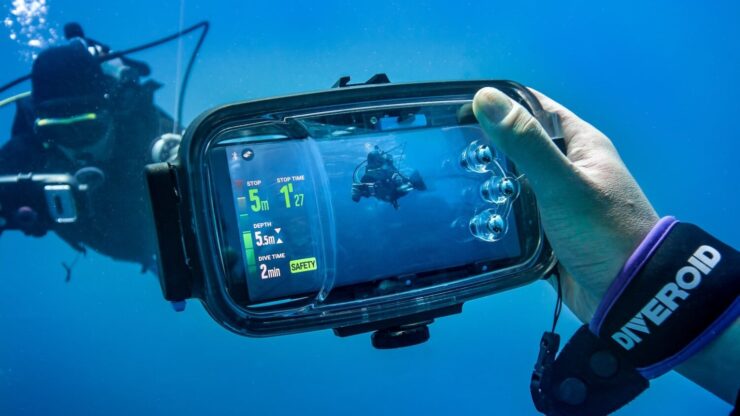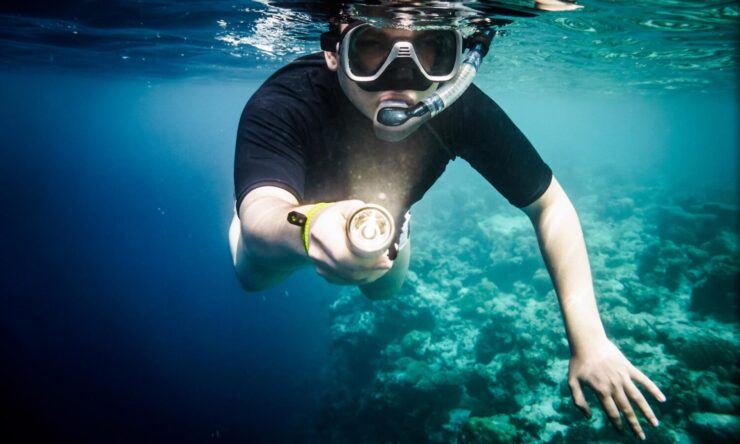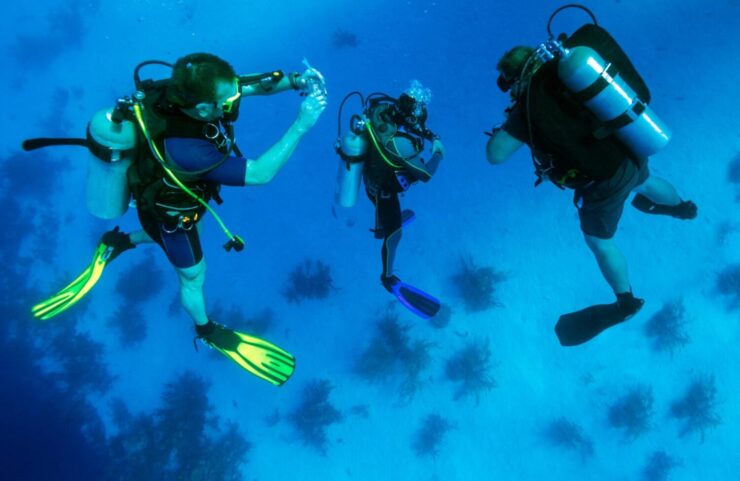Scuba diving is an enthralling adventure that reveals an awe-inspiring underwater world. However, this exploration must be coupled with safety. Equip yourself with these essential accessories to ensure a thrilling, yet secure dive. These must-have items are carefully chosen to enhance your underwater experience while prioritizing safety at every turn.
From a well-fitting dive mask that offers a clear field of vision to a reliable dive computer that keeps track of crucial information, each accessory plays a vital role in ensuring a safe and enjoyable dive. By investing in these scuba diving essentials, you can embark on your underwater journey with confidence, knowing that you are equipped for a memorable and secure dive.
Dive Mask: Your Window to the Underwater World

A dive mask is not just an accessory but an extension of your very senses underwater. When choosing a dive mask, consider the fit, comfort, and quality. It should have a snug seal to keep the water out and be comfortable enough to wear for extended periods. The tempered glass should provide a clear field of vision, allowing you to observe the underwater environment in all its glory.
The mask should have an easily adjustable strap and a nose pocket that enables you to equalize pressure as you descend. This is crucial in preventing a mask squeeze, which can be uncomfortable or even harmful. Mask with a low volume makes it easier to clear water if needed. Moreover, consider getting a mask with corrective lenses if you wear prescription glasses, so your vision remains sharp underwater.
Opt for silicone skirts as they are durable and provide a better seal compared to plastic. Investing in a high-quality dive mask is investing in a plethora of clear visions of the underwater wonders.
Snorkel
While scuba diving takes you beneath the waves, a snorkel keeps you breathing effortlessly on the surface. A snorkel conserves tank air before descent and is vital during surface swims or if you have to wait at the surface for any reason.
A dry snorkel is recommended as it prevents water from entering the tube when submerged. When paired with your dive mask, it should allow for easy observation of marine life from the surface without lifting your head, which can be an incredibly serene experience.
In case of air depletion or an emergency ascent, a snorkel is invaluable for catching your breath at the surface, especially in choppy water.
Fins

Think of fins as your engine underwater. They provide efficient propulsion, and the right pair will conserve your energy, making your dive more enjoyable. There are two primary types of fins: open-heel and full-foot. Open-heel fins are versatile and can be worn with dive boots; they’re excellent for varying diving conditions. Full-foot fins are lighter and can be ideal for travel.
Fins come in different stiffness levels. Stiffer fins provide more propulsion but require more effort, while more flexible fins are easier to kick but provide less thrust.
Split fins are an alternative design that reduces effort and fatigue. They are great for leisurely diving but might not be the best choice for fighting currents. Lastly, adjustable straps or spring straps make donning and doffing the fins easier.
Wetsuit or Drysuit
Diving exposes you to a range of temperatures and environments. A wetsuit or drysuit is not just about warmth; it’s your shield. Wetsuits work by trapping a thin layer of water between the suit and your skin, which your body warms.
Drysuits, on the other hand, keep you dry and are used in colder waters. They allow for thermal undergarments and offer better insulation. Both wetsuits and drysuits also provide protection against sun, abrasions, and stings.
It’s important to ensure a good fit. Too loose, and water will flush through the suit, taking away your warmth. Too tight, and it could restrict movement and become uncomfortable.
Dive Computer

A dive computer is a device that calculates and displays essential dive data. It is your best buddy underwater, providing real-time information on your depth, dive time, ascent rate, and the necessary decompression stops.
These computers calculate nitrogen absorption and elimination in your body, providing safe limits for your dive. They often feature audible and visual alarms for ascent rate, depth limits, and dive time to keep you within safe parameters.
Buoyancy Control Device (BCD)
Achieving neutral buoyancy, the state where you neither sink nor float, is essential for a comfortable and safe dive. A Buoyancy Control Device (BCD) allows you to manage your buoyancy by controlling the amount of air in your inflatable vest.
BCDs also serve as the rig to carry your tank, weights, and other equipment. They come in different styles like jacket style, back-inflate, and wing-and-backplate systems. Each style has its advantages and suits different types of diving. It’s important to choose a BCD that fits well, has enough lift capacity for your needs, and adequate pockets or D-rings to carry accessories.
Regulator
The regulator is a marvel of diving technology. It takes the high-pressure air from your tank and delivers it to you at ambient pressure so you can breathe comfortably underwater. It can be used in combination with a pressure sensor. It’s crucial to invest in a reliable, high-quality pressure sensor like the Zoop one you can find here.
Regulators consist of a first stage that attaches to the tank and reduces the high pressure to an intermediate pressure, and a second stage that you breathe from, further reducing the pressure to ambient levels. It’s crucial to invest in a reliable, high-quality regulator for your safety. To get the most from a high-quality regulator, many divers pair it with carbon composite cylinders, which offer a strong, lightweight option for safely managing high tank pressure throughout the dive.
Many regulators offer features like adjustable inhalation effort, venturi switches to prevent free flows, and balanced designs for consistent breathing at all tank pressures and depths.
Weight System
A weight system is essential to counteract the buoyancy of your body and your equipment. By correctly distributing the right amount of weight, you can achieve neutral buoyancy, which allows you to hover underwater, ascend, or descend at will.
Weight systems come in various forms: weight belts, weight harnesses, or integrated into your BCD. Soft weights or hard weights can be used depending on preference and the system used. It’s crucial to distribute weight evenly to maintain balance underwater.
Determining the right amount of weight requires a buoyancy check. Always remember, you should be neutrally buoyant at the surface with an empty BCD and nearly empty tank.
Dive Light

Whether you’re diving during the day or night, a dive light is essential. It enhances colors, illuminates dark spaces, and allows for better observation of marine life. It’s especially crucial for safety during night dives, deep dives, and when exploring wrecks or caves.
Dive lights range from small back-up lights to primary dive lights with high lumens for more brightness. A dive light with a good balance of beam width and intensity can make your underwater exploration more enjoyable.
Safety Sausage or Surface Marker Buoy (SMB)
A safety sausage or SMB is a critical safety tool for divers. It’s an inflatable tube that can be filled with air from your regulator or orally and sent to the surface to signal your location.
They are invaluable in marking your position to the boat while ascending in open water or when surfacing far from the boat. They can also signal distress in emergency situations.
Inflatable on the surface or at depth, SMBs are available in various styles and sizes. Consider an SMB with a high visibility color like orange or yellow and a reflective strip for increased visibility.
Dive Knife or Cutting Tool
Despite its aggressive image, a dive knife is an essential safety tool. Its primary purpose is not protection against marine life, but freeing oneself or a dive buddy from entanglement in fishing lines, nets, or kelp.
Knives can be made from stainless steel or titanium. While stainless steel is cheaper, it requires more care to prevent rusting. Titanium knives are lighter, rust-proof but more expensive.
Alternatively, line cutters or z-knives can be safer and more effective for cutting through lines or nets. Choose a knife or tool that can be securely mounted and easily accessed.

